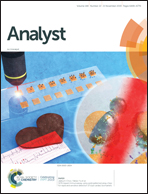A carbon dot-based fluorescent nanoprobe for the associated detection of iron ions and the determination of the fluctuation of ascorbic acid induced by hypoxia in cells and in vivo†
Abstract
Maintaining the redox balance of biological systems is a key point to maintain a healthy physiological environment. Excessive iron ions (Fe3+) can cause apoptosis, tissue damage and death. Fortunately, ascorbic acid (AA) as a reducing agent has been evaluated for the reduction of Fe3+. Moreover, AA plays an important role in relieving hypoxia-induced oxidative stress. Therefore, the real-time imaging of the Fe3+ and AA fluctuations is important for understanding their biofunctions in cells and in vivo. In this work, we developed a fluorescent nanoprobe carbon dot-desferrioxamine B (CD-DB) by the conjugate connection of CDs and desferrioxamine B (a complexing agent for Fe3+) for the associated detection of Fe3+ and AA. CD-DB exhibited excellent sensitivity and selectivity for the detection of Fe3+ and AA. The nanoprobe CDs-DB@Fe obtained by the reaction of CD-DB and Fe3+ was suitable for tracing the dynamic changes of AA in cells and in vivo. Therefore, CDs-DB@Fe was used for monitoring the fluctuation of AA in hypoxic cell models, hypoxic zebrafish models and liver ischemia mice models. These results exhibited the decrease in AA under hypoxic conditions because AA was consumed to neutralize free radicals and relieve hypoxia-induced oxidative stress damage. The ideal biocompatibility and low toxicity make our nanoprobe a potential candidate for the research of the physiological effects of AA in vivo.



 Please wait while we load your content...
Please wait while we load your content...